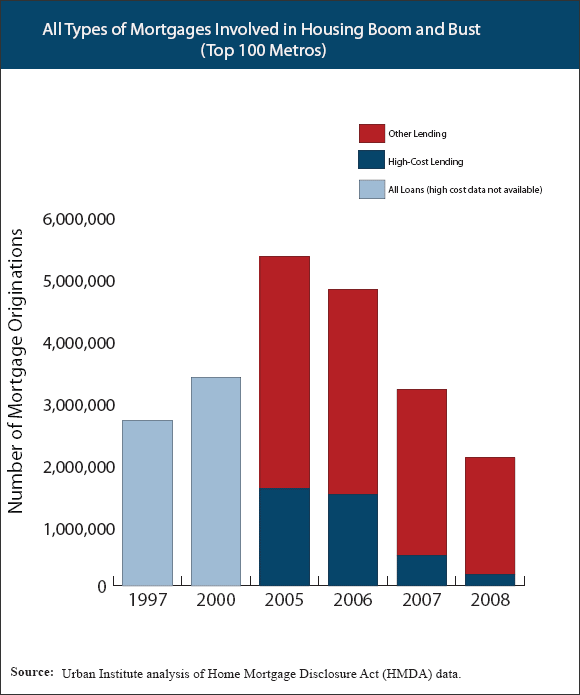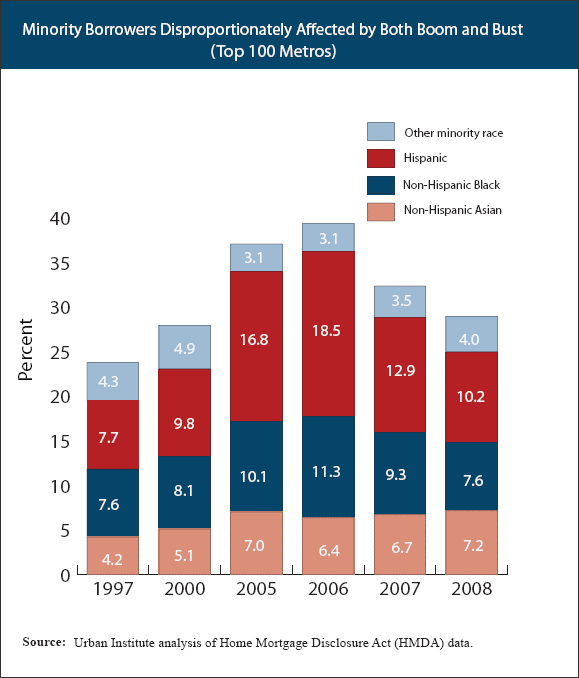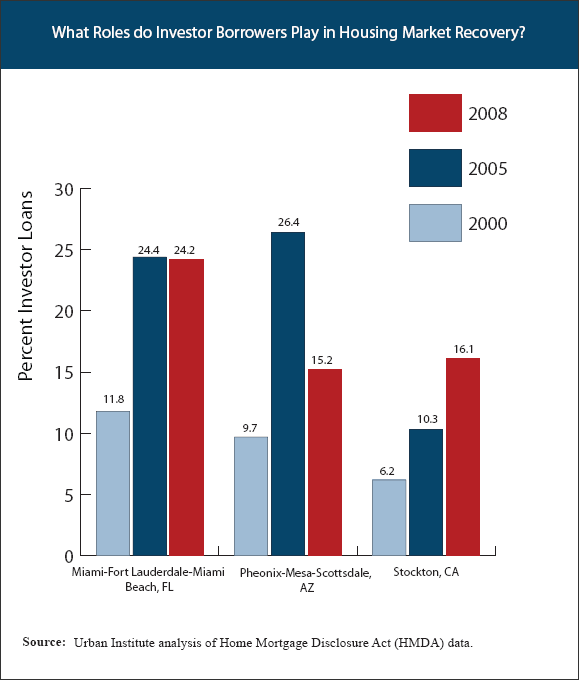
|
|
Muddling the Mortgage Market Investor-Owners in the Boom and BustThe last decade saw mortgage lending soar and then plummet in US metropolitan areas. In the 100 biggest metro areas, the number of home purchase mortgage originations doubled from 1997 to the market peak in 2005, climbing from 2.7 million to 5.3 million before declining to 2.1 million in 2008. While the growth of subprime lending during the boom years has been in the spotlight, growth in the number of lower-cost mortgage loans deserves attention too.* The number of lower-cost home purchase loans in the top 100 metros in 2005 surpassed the total number of loans in 2000. Of the total loans in 2005, 29 percent were high-cost. In every year since, both types of lending have dropped. From 2005 to 2008, subprime lending fell by 88 percent, and the number of lower-cost loan originations dropped by 50 percent. Minority home buyers were much more likely than whites to use high-cost loans. In 2005, 55 percent of African American and 48 percent of Latino mortgage seekers used high-cost loans to purchase their homes.1 That's 3.3 and 2.9 times the rate for whites, respectively. As housing credit has tightened, minority borrowing has disproportionately declined. In 2000, 28 percent of borrowers in the top 100 metros nationwide were minority. Over the next six years, their share climbed by 11 percentage points. But by 2008, these gains had disappeared and the minority share of borrowers had sunk back to its 2000 level. Latinos have seen the largest declines, falling from a high of 18 percent of all borrowers in 2006 to only 10 percent in 2008. How fast and fully many metros rebound depends partly on what investor-owners - borrowers who do not use the newly-bought home as their primary residence - do next. People have historically bought investment properties for multiple purposes, and that continues to be the case today. Those who buy properties as vacation homes or long-term investments to rent out can absorb excess inventory and help stabilize local inventory and prices. This could be especially important in markets with numerous foreclosures or high levels of existing inventory. But investor-owners hoping to "flip" or sell quickly to take advantage of price increases might be more problematic. They often leave properties vacant - which can invite vandalism, undermine nearby housing values, and destabilize prices. However, investors may also react to changing conditions by changing their actions. For example, "flippers" may decide to rent their properties if they find they cannot sell them off quickly. The markets with the highest shares of investor borrowers are in Florida and other vacation spots. The top four in 2005 were in Florida (Bradenton, Lakeland, Orlando, Palm Beach), as were 7 of the top 15. But if demand for vacation properties isn't news, the dramatic increase in the share of investor borrowers during the last decade is. For example, in the Bradenton-Sarasota-Venice area, that share rose from 22 percent in 1997 to 40 percent in 2005, falling to 30 percent in 2008. Most likely, those who bought vacation properties were joined by speculative investors at the boom's peak. Most of the hot markets of 2005 saw declines in the investment share by 2008. In contrast, some metros have seen the share of investor activity climb since 2005. Six of the top 15 with rising shares are in California. For example, the share of investor borrowing rose from 13 to 19 percent in Santa Rosa and 10 to 16 percent in Stockton. Investor activity also rose in five Southern metros (Chattanooga, Jackson, Memphis, Louisville, and Knoxville); three Northeastern metros (Lancaster, Portland, and Boston), and Des Moines in the Midwest. Unfortunately, national data can't tell us whether buyers in these markets are making long-term investments in rental property or just looking for a quick profit when prices finally rebound. Three metros illustrate the differing roles of investor-owners in today's weak housing markets. Miami, Phoenix, and Stockton all saw home prices fall by one-third or more between 2007 and 2009 (following earlier run-ups in prices). Miami and Phoenix are retirement and vacation areas, but Stockton's story is different. The boom drew more investors into all three markets between 2000 and 2005, but their paths have diverged since. Investors remain a powerful force in Miami's market, but have pulled back in Phoenix. The jump in the share of investor loans in Stockton may reflect bargain-hunting after the precipitous price drops there. Chart: What Roles do Investor Borrowers Play in Housing Market Recovery? Given investor home buyers' potential roles in re-stabilizing individual markets, local officials and researchers need to better understand the motivations of buyers in their particular market. State or local policies can be adopted that encourage home-ownership or long-term investments rather than flipping. To help stabilize home values, communities could make property tax rates for owner-occupied homes lower than those on investment properties. To discourage short-term sales, they could introduce transaction fees or recordation fees. And they could introduce financing assistance programs for investors offering affordable rental housing. *Home Mortgage Disclosure Act data identify "high-cost" loans, defined as those with interest rates 3 percentage points above a comparable U.S. Treasury yield. "Lower-cost" loans refer to loans with interest rates that are 3 percentage points or less than a comparable U.S. Treasury yield. Figures in this paragraph include all first-lien and second-lien mortgages. 1The rates by race include conventional first-lien owner-occupied home purchase loans. Conventional loans are those not insured by the government. |
Experts Feedback
Send us your comments to help further the discussion. Share
Commentaries
|








 Kathryn L.S. Pettit
Kathryn L.S. Pettit Kim Rueben
Kim Rueben